By KATHERINE McGILL, TOM PIPERSON & BIRGIT SOMMER
July 20, 2009
Most folks in the US and Erath County have encountered the resourceful raccoon, or at least have dealt with the mess or damage these furry creatures leave behind in their foraging activities. But coexisting with these intelligent animals is not so much of a nuisance once you understand their place in the ecosystem. 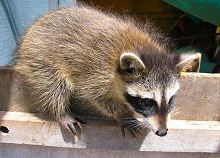 | Raccoons are medium sized mammals but do not belong to the rodent family. They are loosely related to the red panda bear and can be found almost anywhere in Texas and throughout the US where there is water and food. |
Like the black bear, the raccoon is opportunistic and insatiably curious. If you find yourself outwitted by a raccoon, don’t take it personally. The raccoon’s intelligence is second only to higher primates, according to researchers at Purdue University. Studies have shown that raccoons are able to remember the solution to tasks several years later.
| While raccoons control populations of rodents, reptiles, insects, and snakes, they also add berries, fruits and vegetables to their diet, as well as poison ivy berries, controlling the spread of this noxious plant. According to legend, raccoons are fearless feeders that will eat an entire wasp nest or even gang up on a rattlesnake. Humans, coyotes, mountain lions, and birds of prey are the raccoon’s natural predators. | 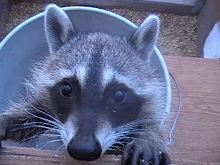 |
Possession of a raccoon is illegal in Texas, but permits are available through the Texas Parks and Wildlife Department for wildlife rehabilitators and researchers. These laws have not stopped a few well-meaning folks from attempting to raise a raccoon as a pet, which typically has a tragic ending. The animal becomes destructive while deprived of its natural habitat or law enforcement intervenes, confiscates and euthanizes the animal while issuing a hefty citation to the owner.
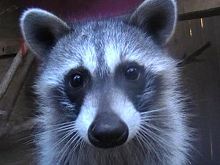 | Although exceptional climbers, very clever, and gifted with an excellent sense of smell, the life span of a raccoon in the wild rarely exceeds two to four years. Some of the primary hazards faced by raccoons include hunting, trapping, dogs, and automobiles, and a lack of understanding or tolerance for their instinctual behavior. |
It seems more than mere evolution that they wear a distinctive bandit mask, as anyone who has been a victim of their food seeking behavior can attest.
If you desire to keep wild animals away from your property, the raccoon may give you a challenge. Ammonia soaked rags or ground red pepper near entrances will help, later sealing the entry. Be sure to give a mother time to remove her babies lest you trap them and cause yourself a worse mess. In time, when the babies are older, they will all move out anyway.
Obviously, figuring out how to secure pet food and trash cans is your best bet – and challenge. A simple bungee cord is no match for the wise and dexterous raccoon!
To be sure, generations before us managed to coexist with wildlife, and survived all the risks and fears that are still with us today, such as the myth about raccoons as carriers of disease. There has only been one confirmed case of a rabies infected raccoon in Erath County since 2001 and that was accredited to a skunk bite. Human rabies deaths are nearly zero in the US, except for a few unfortunate victims bit by a rabid dog while visiting a foreign country.
Most wildlife experts agree that distributing rabies vaccine into the wildlife population using bait is the most effective prevention method for permanent eradication of the virus. Rabies vaccine oral bait drop programs have been used in affected areas thru the US with tremendous success. | 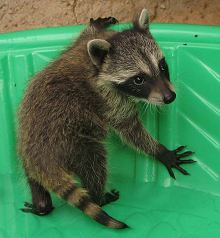 |
According to the US Centers for Disease Control, the unvaccinated population (humans, unregistered pets, other mammals and rodents) must be infected by the saliva or bite from a rabies infected animal in the contagious phase of the disease. A rabid animal is only considered “contagious” when the disease has affected the brain. At this late stage, the animal is noticeably ill.
Rabies in wild animals can only be determined by sending its brain to a lab for testing. Hundreds of thousands of brains are submitted; relatively few return a positive result. Yet each year some 25,000 people receive post-exposure “just in case” rabies shots which can skew statistics. But testing is a costly process for the US.
Because rabies is a potentially fatal health concern, experts encourage simple preventive measures such as vaccinating pets and not handling wildlife.
Parasites are another potential hazard, although wild raccoons are immune to it, but do sometimes carry, what is malignly called “the raccoon roundworm”, or Baylisascaris procyonis.
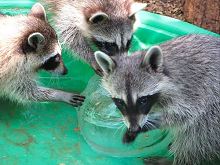 | In reality, over 90 species of both wild and domestic animals can host this roundworm. Keeping pets dewormed is common sense, also not eating poop, which may be a concern for small children. To date, less than 30 cases of B. procyonis have ever been recorded in humans in the US. |
Contrary to popular belief, observing a raccoon out during daylight hours does not mean the animal is ill. Although nocturnal animals, by definition, never venture out during the day, it is common for mother raccoons and adventurous youngsters to be seen in the daytime, particularly in neighborhoods with little threat of danger.
A sick animal will show obvious symptoms. Raccoons pant and can even sweat when overheated. Distemper disease is often mistaken for rabies in raccoons. The best way to prevent distemper is to vaccinate all cats and on regular basis.
If you encounter a sick, injured, or possibly orphaned animal, you can find a list of licensed wildlife rehabilitators on the Texas Parks and Wildlife Website. If the animal is not in immediate danger from predators or the elements, leave the animal there until you speak with a rehabilitator. They are volunteers of the state trained to assist wildlife and will give you the best advice possible. Those who work with wild animals will tell you – they have never met an aggressive animal, only a scared one.
Erath County has its own licensed wildlife rehabilitator. Birgit Sommer is the director of the Rainbow Wildlife Rescue, a non-profit organization, located on the south-east side of Stephenville. If you have any questions about local wildlife or found an injured or orphaned animal, you can obtain important information on her website located at www.rainbowwildlife.com or call her at 968 - 4626. | 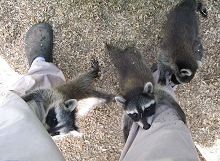 |
Let us not forget that raccoons have but one goal – to survive. After all, snakes, mice, and poison ivy berries are the real nuisances we are much better without.
--------------------
Thank you to KATHERINE McGILL, who provided the groundwork for this article. You can visit her Sunchaser Wildlife Website HERE!
Thank you Tom Piperson for the editing and final polishing!
Disclaimer: The information provided in this article is the property of the Rainbow Wildlife Rescue. The RWR holds all copyright interests in such material, unless specifically indicated. Permission to reprint is given with credit to the Rainbow Wildlife Rescue and noted authors.

